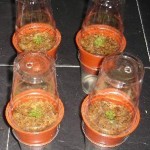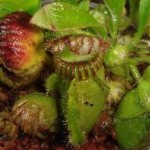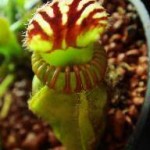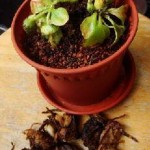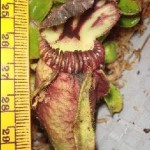Author: Cindy Ng
Date: 6 August 2007
Edited By: David
Cephalotus is not difficult to grow in the tropics. Having more heat resistant clone helps. On top of that, cooling is important.
Growers who provide even a night drop with air-condition (~23-25degC) have larger pitchers. With heat somehow the pitchers remain small but there are plenty of off shoots. My largest plant is a clump of at least 50 pitchers. But they are all 1cm and less.
One grower places his plant in an air-conditioned room with temperatures as low as 16degC has fewer pitchers on the plant… at most 10 pitchers. However, the pitchers much larger and look like matured pitchers. Mine did produce ONE adult pitcher during the cooler months last year but then again, my Cephs are all at my balcony which faces North-West. From 3pm onwards, it becomes very hot.
I water my Cephs only about 2-3 times a week. There are a few pots of them in different media. Peat/sand, peat/coarse sand, LFS/coarse sand, LFS/perlite. I don’t see a difference in the mix although I was advised by the donor never to use LFS. My largest clump happens to be in LFS/perlite. Perhaps because I am careful with watering, the mix still works.
Cephalotus does well in bright shade. They do not need direct sunlight. The more light they are given, the smaller the pitchers become. No doubt that they will have some red on them with very bright light but since they are so small it doesn’t quite make a difference. Less light and cooler conditions will give larger pitchers. Once the pitchers are of a good size, then you might want to increase the light intensity.
The danger in cultivating Cephalotus is in forgetting to water them! If the roots are too dry, the plant will turn yellow and it will lose half of its leaves.
All except two pots of my Cephs are covered with a plastic container. There is a hole on top for air-circulation. This is not necessary but I kinda like the way the pot looks. It started out as a way to harden TC Cephs but since the plants are doing well, I left the covers on. I have one at my windowsill exposed to very bright light and some direct sunlight (windows are tinted). Another plant is under flourescent light.
Author: Cindy Ng
Date: 26 October 2007
Cephalotus follicularis is also known as the Albany Pitcher Plant or West Australian Pitcher Plant. This distinctive species has a reputation of being difficult to grow but once the plants establish themselves, the effort is absolutely worthwhile.
This species is not readily available for purchase even from overseas nurseries. If available, they are costly. To top that, the species does not ship well and many newly purchased plants die soon after, especially if their needs are not well taken care of.
In March 2006, I had the opportunity to purchase two pots of tissue-cultured Cephalotus. It was already hardened in the nursery greenhouse for about 6 months. This was the beginning of my Cephalotus journey (or madness as some of my CP friends would call it).
The above plant is grown at my balcony which faces north, slightly to the west. It is sheltered from the rain but receives direct sunlight for some part of the day. The media used consists of long fibre sphagnum (LFS) and perlite. Watering is only carried out when the LFS on the surface is dry as the media needs to be kept moist but not wet.
Other than the hardened TC plants, I also had the chance to handle fresh TC material from a kind donor. The potted plants are covered with a cup to keep the humidity high. The hole on the top is for ventilation.
Until today, the plants are still in the same set-up. The reason is simple: do not fix what is not broken. If the plant is doing well for you, leave it alone to grow as it pleases. Well, at least that is a rule for Cephalotus.
So is the end of my madness? Nah recently acquired some mature plants (2-4 years old) which are cuttings. They are from a dear friend who lives in Western Australia. He has been growing Cephalotus for two decades.
The plants are potted in assorted media (peat/perlite, peat/sand, peat/washed leca etc). The proportion starts from 25% to 50% peat.
Hurray!!! Shall we all rush and start ordering the Cephalotus?
First, take a look at this photo. This is the amount of pitchers you may lose from the shipping. Some of the leaves have turned yellow too.
So why am I still so obsessed with growing this plant?
There is a sense of achievement when the pitchers start to colour up in my conditions! And of course, I do hope one day they will grow up to this size?
FAQ
Are newly deflasked TC plants easy to grow?
Tissue cultured plants which are newly removed from the agar needs to be kept in high humidity. Even so, air ventilation is important and I found the set-up recommended by tropica (Mr Lin) very useful. The plant is potted up and covered with a cup. A hole would have to be made on the bottom of the cup to aid ventilation. Surrounding the TC Cephalotus with live sphagnum moss also helps. The plants are watered once a week by misting.
TC plants can eventually be hardened to lower humidity by slowing increasing the size of the hole on the cup or via the use of a Ziploc bag. This process takes about 2-3 weeks. If you have live sphagnum moss in the pot, they will dry up by that time so do remove them if you intend to keep them.
How can Cephalotus be best acclimatized to my growing conditions?
Most nurseries keep their plants in very high humidity to maintain the pitchers for a long period of time. A new plant need to be kept in high humidity after potting, in a Ziploc bag. The bag can be opened little by little over 2-3 weeks.
Another tip which I picked up from Matt K. (quote) is to harden the roots. Just place the bareroot plant in a slightly opened Ziploc bag with a piece of moist tissue paper over a week before potting.
Can tap water be used on Cephalotus? And how often should I water the plant?
Singapore tap water is alright to use on this species. As to the frequency of watering, there are two schools of thought. Some growers water their Cephalotus overhead on a daily basis since in the wild Cephalotus have running water flowing through their roots. Others prefer to water only 1-2 times a week, keeping the media just moist and not wet.
It depends largely on the media that is used. The looser the mix i.e. higher percentage of perlite or sand, the more often you can water the plants.
What are some useful websites on the cultivation of Cephalotus?
Cephalotus follicularis
International Carnivorous Plant Society
Where can Cephalotus be bought from?
Cephalotus is not sold in our local nurseries and is currently available only from online nurseries. Triffid Park, Southern Carnivores and the Ebay are sources for the species


